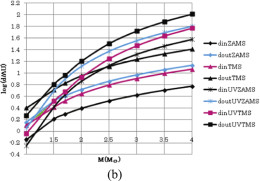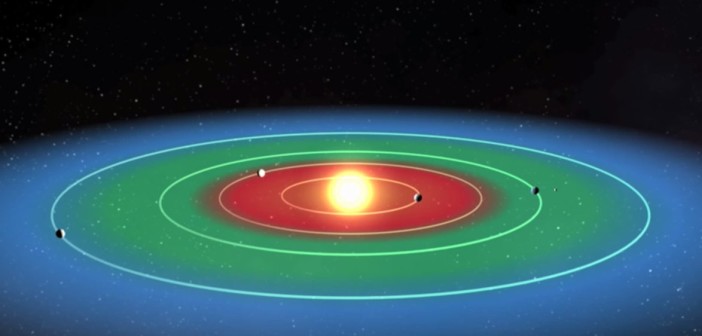Where should we search for life in the universe? Habitable zones are traditionally determined based on the possibility of liquid water existing on a planet — but ultraviolet (UV) radiation also plays a key role.
The UV Habitable Zone

Schematic showing how the traditional habitable zone’s location and width changes around different types of stars. The UV habitable zone also has different locations and widths depending on the mass and metallicity of the star. [NASA/Kepler Mission/Dana Berry]
To determine the most likely place to find persistent life, we should therefore look for the region where a star’s traditional habitable zone, within which liquid water is possible, overlaps with its UV habitable zone, within which the UV flux is at the right level to support life.

Relationship between the stellar mass and location of the boundaries of the traditional and UV habitable zones for a solar-metallicity star. din and dout denote inner and outer boundaries, respectively. ZAMS and TMS denote when the star joins and leaves the main sequence, respectively. The traditional and UV habitable zones overlap only for stars of 1–1.5 solar masses. [Adapted from Oishi and Kamaya 2016]
Looking for Overlap
In a recent study, two scientists from the National Defense Academy of Japan, Midori Oishi and Hideyuki Kamaya, explored how the location of this UV habitable zone — and that of its overlap with the traditional habitable zone — might be affected by a star’s mass and metallicity.
Oishi and Kamaya developed a simple evolutional model of the UV habitable zone in stars in the mass range of 0.08–4 solar masses with metallicities of roughly solar metallicity (Z=0.02), a tenth of solar metallicity, and a hundredth of solar metallicity.
They calculate the location of the inner and outer UV habitable zone boundaries for each star at the beginning and end of its main-sequence life. They then determine the region for which the UV habitable zone and the traditional habitable zone overlap — which maximizes the potential to support persistent life.
The Field Narrows

Relationship between the stellar mass and location of the boundaries of the traditional and UV habitable zones for a star of one hundredth solar metallicity. The traditional and UV habitable zones do not overlap for stars of any mass. [Adapted from Oishi and Kamaya 2016]
As metallicity of the host star decreases, the overlapping regions decrease as well: at a metallicity of one hundredth that of the Sun (Z=0.0002), the UV and traditional habitable zones do not overlap for any mass star.
The authors point out that this does not necessarily mean that such stars can’t support life. Stellar activity such as flares and coronal mass ejections can temporarily increase UV flux, possibly providing enough to make up for low steady-state flux. And oceans on planetary surfaces could shield potential life from UV flux that is too high.
Nonetheless, the estimates of the UV habitable zone in this study help us to narrow down the most probable places for finding life in the universe.
Citation
Midori Oishi and Hideyuki Kamaya 2016 ApJ 833 293. doi:10.3847/1538-4357/833/2/293


1 Comment
Pingback: zones for life just got narrower